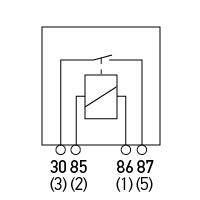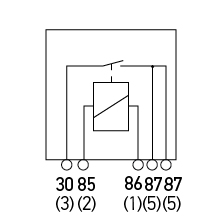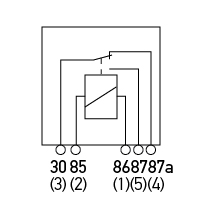Eliminating Voltage Spikes
Voltage spikes from 300V to 500V can occur momentarily when a relay is switched off. Sensitive electronic equipment can be damaged or malfunctions can occur if these spikes reach the vehicle electrical network without suppression. A relay with a diode eliminates voltage spikes completely.
Common Pin Designations for Relays
| Pin No. | Description |
| 85/2 | Earth (end of winding to ground or negative) |
| 86/1 | Positive |
| 87/5 | Output (to consumer e.g. driving lamp) |
| 87a/4 | Alternative output (1st output, break side) |
| 30/3 | Positive supply (Input from + battery terminal, direct) |
|
The Different Types of Relays |
||
| The Normally Open Relay | The Normally Open Relay with Dual Output |
The Change-over Relay |
 |
 |
 |
| A normally open relay is used to close the electric circuit between power source and electrical load, i.e. the load is switched on. Relays are operated by means of switches, pulse generators or control devices.
Application: Headlamps, auxiliary driving lamps, auxiliary fog lamps, horns, heaters, motors for fans and power windows, air-conditioners and ignition assemblies. |
The change-over relay changes the load path from one electrical load to another. The relay is operated by a dashboard switch.
Application: Switching over from town horn to fanfare horn, for 2 speed appliances such as heated rear window or fan motors. Change-over relays |
|
Relays have been predicted to be obsolete in modern vehicles, however the automotive industry needs relays since relay functions cannot always be replaced by control units. Only relays make “galvanic isolation” possible between input and output. Semi-conductor devices cannot manage this at the moment. Another positive factor is the cost advantage relays have compared with an electronic solution.
In motor vehicles, relays are used to switch high currents. For example the engine control unit is switched by a relay. Their sturdiness allows them to be installed near electric consumers. As only low control currents are required, the cable cross-sections can be kept small. The switching/amplifier function of a relay can only be achieved with a lot more effort and a lot less reliability using “modern” electronics. An additional advantage is that the replacement of a relay is quick and easy. These characteristics guarantee that relays will have a regular place in many vehicles for a long time to come.
Trust in our Quality Relays
> Production expertise: HELLA produces more than 100 million relays per year. Thanks to optimised production we can offer a competitive price for customers. HELLA relays have an extremely low failure rate.
> OEM customers: HELLA develops and produces relays for AGCO, Claas, Daimler AG, Ford, VW, GM, JCB, Opel, Nissan, John Deere, Chrysler and Jaguar/Land Rover among others. We have been working with many customers for decades.
| RELAY QUICK REFERENCE CHART | Download pdf |
